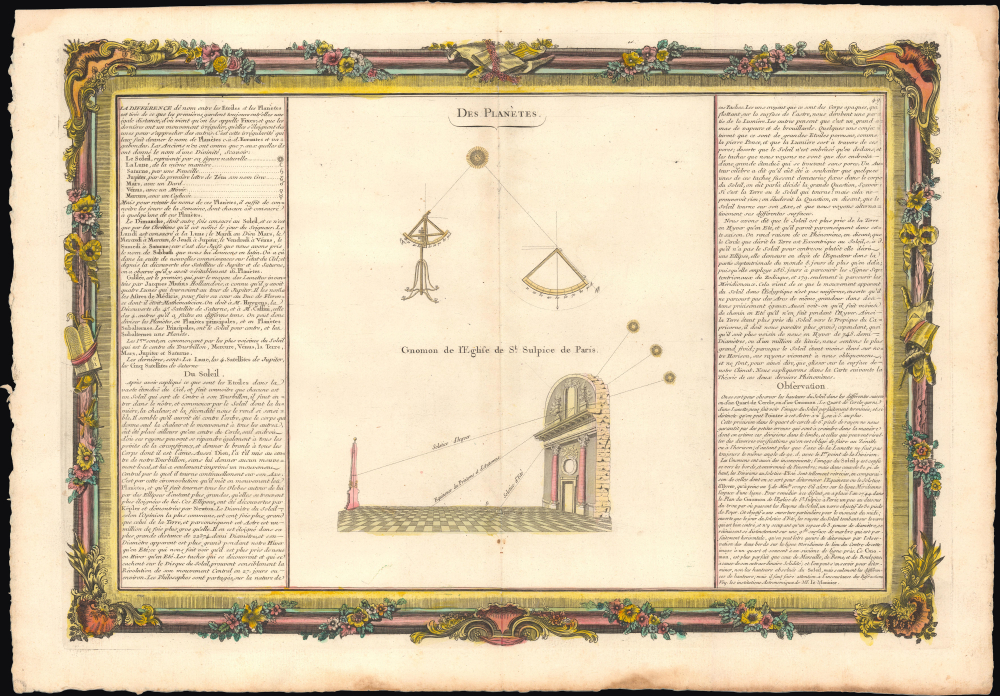This item has been sold, but you can get on the Waitlist to be notified if another example becomes available, or purchase a digital scan.
1761 Desnos / Mornas Tour Diagram of Astronomical Observation
DesPlanetes-desnos-1761
Title
1761 (undated) 14.5 x 20.75 in (36.83 x 52.705 cm)
Description
A Closer Look
The sheet contains a central section with an illustration of a sextant, below which appears a diagram of the Gnomon of St. Sulpice (discussed below) and its use in determining the solstices and equinoxes. Columns of text at left and right discuss the Sun and the planets, their relation to the naming of the days of the week, and the development of astronomical observation of the planets from the Ancients through Galileo, Huygens, and Cassini. Most of the discussion deals with the Sun and its nature, sunspots, the elliptical revolution of planets around the Sun, and the solstices. Taken as a whole, the sheet reflects an increasingly modern understanding of astronomy, including that the stars seen in the sky are each the center of their own solar system ('tourbillon').The Gnomon of St. Sulpice
The current church of Saint-Sulpice in the 6th arrondissement of Paris was built in the mid-17th century and elaborated several times thereafter, to the point that it is the second largest church in Paris after Notre-Dame. Upon one of these renovations in 1727, the church's priest Jean-Baptiste Languet de Gergy (1674 - 1750) asked for a gnomon to be installed in a south-facing window of the church's transept. At solar noon each day, a beam of sunlight passes through the gnomon and lands on a brass meridian line inlaid into the church floor, which runs north-south and is marked with calibrated scales. At the far (north) end of the meridian line is an obelisk, the top portion of which is lit with the winter solstice. Gergy wanted to use the gnomon to more accurately set clocks in Paris and to determine the proper date for Easter. It was also used by later scientists to measure variations of the ecliptic (revolution of the Earth around the Sun), variations in the tilt of the Earth's axis, and the date of the perihelion (when the Earth is closest to the Sun in its annual elliptical orbit).Publication History and Census
This sheet was issued in the 1761 edition of the Atlas General Methodique et Elementaire, pour l’Etude de la Geographie et de l’Histoire Moderne by Louis-Charles Desnos and Claude Buy du Mornas. This sheet is not independently cataloged in any institutional collections, while the entire atlas is well-represented.CartographerS
Louis Charles Desnos (1725 - April 18, 1805) was an important 18th century instrument maker, cartographer and globe maker based in Paris, France. Desnos was born in Pont-Sainte-Maxence, Oise, France, the son of a cloth merchant. From April of 1745 he apprenticed at a metal foundry. Desnos married the widow of Nicolas Hardy, sone of the map, globe, and instrument seller Jacques Hardy. Desnos held the coveted position of Royal Globemaker to the King of Denmark, Christian VII, for which he received a stipend of 500 Livres annually. In return Desnos sent the King roughly 200 Livres worth of maps, books and atlases each year. As a publisher, Desnos produced a substantial corpus of work and is often associated with Zannoni and Louis Brion de la Tour (1756-1823). Despite or perhaps because of the sheer quantity of maps Desnos published he acquired a poor reputation among serious cartographic experts, who considered him undiscerning and unscrupulous regarding what he would and would not publish. Desnos consequently had a long history of legal battles with other Parisian cartographers and publishers of the period. It is said that he published everything set before him without regard to accuracy, veracity, or copyright law. Desnos maintained offices on Rue St. Jacques, Paris. More by this mapmaker...
Claude Buy de Mornas (17xx - 1783) was a French geography professor. He published the Atlas Méthodique et Elémentaire de Géographie et d'Histoire jointly with Louis-Charles Desnos (1725 - 1805) in 1761. Desnos claimed the plates for the Atlas Méthodique after Buy de Mornas died. Learn More...

